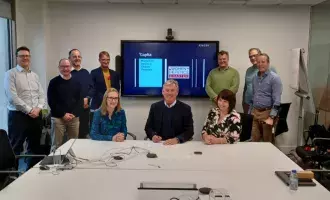James Brooks, Capita CX Innovation Principal, looks at five ‘coming-soon’ tech revolutions that could be game changers for consumers, businesses and retail.
Why is consumer technology important? Because we are living in a consumer-led world. This means we are always scanning the horizon to be at the forefront of the most important technological advances.
In the New Year we’ll be attending CES (the Consumer Electronics Show) in the USA, looking for the developments likely to have the greatest impact on customer experience in 2020. We’ll report back in January but, for the time being, here are five predictions I think we’ll see, and why it will matter.
1) Contact centres powered by thought
In the last 12 months we’ve seen a lot of developments in voice control, plus the beginnings of gesture control. I think the surprise advance in 2020 will be ‘thought control’ of computers and technology. Initially this will be at a very basic level, admittedly, but it will start to become a reality.
When you combine voice, gesture and some degree of thought control, you’re beginning to approach the idea of keyboardless agents. Just them, a screen and a headset, focusing on the conversation they are having with the customer. Not being distracted by having to type or take notes, but calling up what they need through gestures or talking to the computer, or even just thinking about what actions they want to take, and having a headset detect that and carry it out.
Meanwhile the call is being analysed in real time, pushing relevant information to the agent as they are talking. They don’t have to go looking for content, or switch screens; it’s all there ready for them. And I do think that in customer contact it’s going to become more and more about the quality of the conversation, how personalised and relevant you can make it. So thought control of technology could be one more interesting step towards the fully augmented agent.
2) The impact of driverless cars on the insurance industry
It’s clear that we’re going to see more in the connected car and autonomous car spaces, but I think talk will start to turn towards what these technologies are enabling people to do with the extra time they’ve got back. Has it made driving more leisurely, or has it made us more productive because we can now sit in our cars and work? It’s these kinds of questions that will influence where the technology goes.
And the whole thorny issue of insurance –ho’s liable in the case of an accident? Is it still you, even though your car was doing the driving? If that’s the case, how do you now feel about letting go of the steering wheel if the car makes a mistake, but you get blamed? We’ll be doing a big data science piece to look at this, modelling the risk, to see how consumers are feeling and how that will impact the experience and support they will want when they contact our insurance customers. That’s a whole new level of knowledge needed by advisors.
3) 5G
There were some major announcements last year, but I think it’s fair to say there’s a lot more to come from the roll out in the UK. The coverage remains minimal, and the fact that there will be no 5G Apple handset until later in 2020 has also held it back.
But 5G is important, not just for the extra speed, but because of its ability to connect a wide variety of devices together, and many more within a square mile, with greater bandwidth.
We will be watching 5G closely for several reasons. First, because we need to know how it’s likely to affect call volumes in contact centres, and how strong the public’s interest will be. For our mobile provider clients such as O2, Three and Tesco Mobile, it could mean huge peaks in contact volumes when the latest handsets are released, and we need to be prepared for that.
Second, because it will affect areas such as smart metering, that currently relies on the broadband connectivity of individual customers. Equip those meters with 5G and they become completely mobile potentially giving energy companies more control.
And third, because we see a situation arising where the additional connectivity could actually be a challenge for consumers, as well as a benefit. If, for example, they’re trying to get a Samsung device to connect to an Apple device, who do they call? Samsung or Apple? And what if each of those companies says it’s a problem with the other company’s technology?
Giving technical advice on connectivity and enabling consumers to get the most from their devices would be incredibly powerful support to offer – and, we suspect, will be much sought after.
4) Let Alexa do the waiting
Voice systems will continue to get smarter. One of the things we’ve already done is develop an Alexa skill that acts as a voice concierge. If you ask Alexa to contact a company for you, it will use live telephony data to navigate through the interactive voice response (IVR), then tell you how many calls are in the queue and what the wait time is. You’ll have the option of calling and waiting, if the times are not too long, or it will text you the endpoint number so you can make the call when things are quieter. It’s a simple idea, but it could make a major difference to the quality of customer experience for many people.
5) A new reality for the changing room
Augmented reality (AR) and virtual reality (VR) have been around for a while now, but I think a combination of the two – mixed reality – stands to make a bigger impact, especially in the retail sector.
We continue to see the challenge of clicks vs bricks, and whether high street stores are going to shrink or fall away altogether. I think the answer is that they’ll continue but, with the help of mixed reality, they’ll need much less physical space.
I expect to see a wider adoption of ‘magic mirror’ technology, where you have a digital catalogue of clothes down one side. Drag something onto your reflection in the mirror and it will adjust to your body shape and move as you move, so you can see how it fits. Then, rather than taking a physical item to the checkout, you order it online, there and then in the changing room.
So you could end up with stores that no longer need racks and racks of clothes, but can do it all with a dozen intelligent changing rooms. That may be a while in the future yet, but in the time being, I think we’ll start to see new ways of maximising customers’ experiences while they are in the store itself.
Facial recognition is still controversial, and there some questions to be answered there yet. But if retailers could recognise us while we were in store, they could tailor our experiences, maybe messaging our mobile phones to encourage us to go to a particular floor or display where there are items we might be interested in. Or potentially sending a discount voucher if we bought something today.
Join us again in the new year, for our post-CES report, where we’ll be discussing what we saw at the show – and delving deeper into how the tech that’s just around the corner might affect the future of customer experience.

James Brooks
Innovation Lead, Capita Customer Management
James is focusing on process improvement, analytics and technology to help solve industry challenges. He has over 16 years’ contact centre experience, serving in numerous analytical and technology based roles, from the financial services and outsourcing industries. He has a keen interest in the application of AI and Machine Learning to enhance customer experience.







